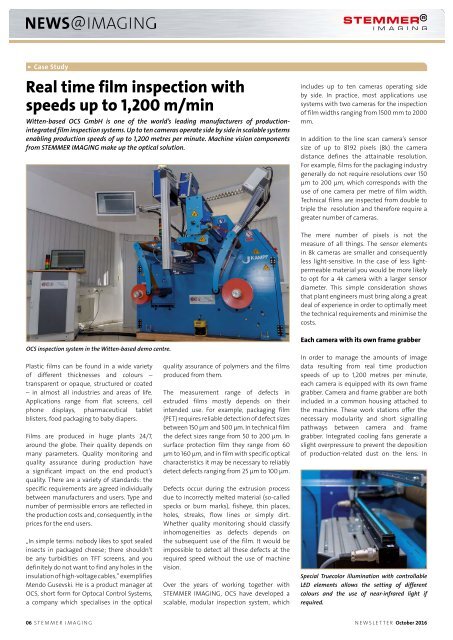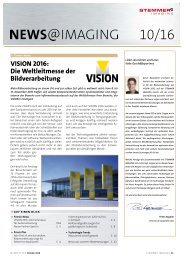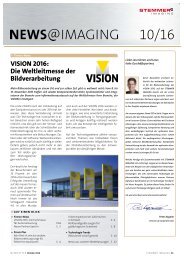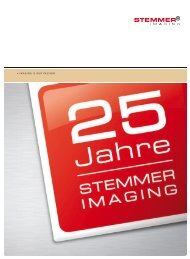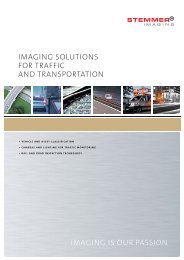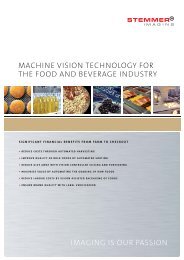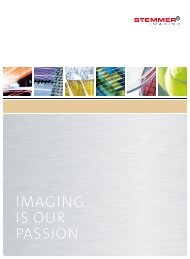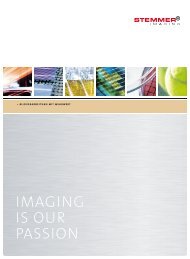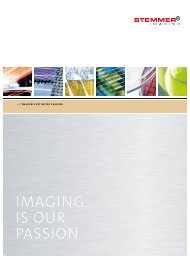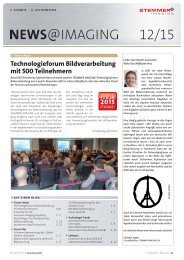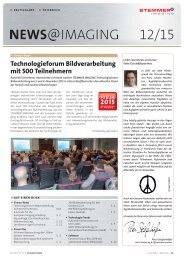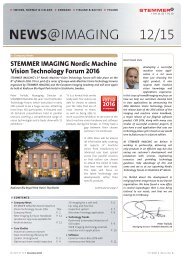Newsletter | EN | 2016-10
NEWS@IMAGING October 2016 English
NEWS@IMAGING October 2016
English
You also want an ePaper? Increase the reach of your titles
YUMPU automatically turns print PDFs into web optimized ePapers that Google loves.
ңң<br />
Case Study<br />
Real time film inspection with<br />
speeds up to 1,200 m/min<br />
Witten-based OCS GmbH is one of the world’s leading manufacturers of productionintegrated<br />
film inspection systems. Up to ten cameras operate side by side in scalable systems<br />
enabling production speeds of up to 1,200 metres per minute. Machine vision components<br />
from STEMMER IMAGING make up the optical solution.<br />
includes up to ten cameras operating side<br />
by side. In practice, most applications use<br />
systems with two cameras for the inspection<br />
of film widths ranging from 1500 mm to 2000<br />
mm.<br />
In addition to the line scan camera’s sensor<br />
size of up to 8192 pixels (8k) the camera<br />
distance defines the attainable resolution.<br />
For example, films for the packaging industry<br />
generally do not require resolutions over 150<br />
μm to 200 μm, which corresponds with the<br />
use of one camera per metre of film width.<br />
Technical films are inspected from double to<br />
triple the resolution and therefore require a<br />
greater number of cameras.<br />
The mere number of pixels is not the<br />
measure of all things. The sensor elements<br />
in 8k cameras are smaller and consequently<br />
less light-sensitive. In the case of less lightpermeable<br />
material you would be more likely<br />
to opt for a 4k camera with a larger sensor<br />
diameter. This simple consideration shows<br />
that plant engineers must bring along a great<br />
deal of experience in order to optimally meet<br />
the technical requirements and minimise the<br />
costs.<br />
OCS inspection system in the Witten-based demo centre.<br />
Plastic films can be found in a wide variety<br />
of different thicknesses and colours –<br />
transparent or opaque, structured or coated<br />
– in almost all industries and areas of life.<br />
Applications range from flat screens, cell<br />
phone displays, pharmaceutical tablet<br />
blisters, food packaging to baby diapers.<br />
Films are produced in huge plants 24/7,<br />
around the globe. Their quality depends on<br />
many parameters. Quality monitoring and<br />
quality assurance during production have<br />
a significant impact on the end product’s<br />
quality. There are a variety of standards: the<br />
specific requirements are agreed individually<br />
between manufacturers and users. Type and<br />
number of permissible errors are reflected in<br />
the production costs and, consequently, in the<br />
prices for the end users.<br />
„In simple terms: nobody likes to spot sealed<br />
insects in packaged cheese; there shouldn’t<br />
be any turbidities on TFT screens, and you<br />
definitely do not want to find any holes in the<br />
insulation of high-voltage cables,” exemplifies<br />
Mendo Gusevski. He is a product manager at<br />
OCS, short form for Optocal Control Systems,<br />
a company which specialises in the optical<br />
quality assurance of polymers and the films<br />
produced from them.<br />
The measurement range of defects in<br />
extruded films mostly depends on their<br />
intended use. For example, packaging film<br />
(PET) requires reliable detection of defect sizes<br />
between 150 μm and 500 μm. In technical film<br />
the defect sizes range from 50 to 200 μm. In<br />
surface protection film they range from 60<br />
μm to 160 μm, and in film with specific optical<br />
characteristics it may be necessary to reliably<br />
detect defects ranging from 25 μm to <strong>10</strong>0 μm.<br />
Defects occur during the extrusion process<br />
due to incorrectly melted material (so-called<br />
specks or burn marks), fisheye, thin places,<br />
holes, streaks, flow lines or simply dirt.<br />
Whether quality monitoring should classify<br />
inhomogeneities as defects depends on<br />
the subsequent use of the film. It would be<br />
impossible to detect all these defects at the<br />
required speed without the use of machine<br />
vision.<br />
Over the years of working together with<br />
STEMMER IMAGING, OCS have developed a<br />
scalable, modular inspection system, which<br />
Each camera with its own frame grabber<br />
In order to manage the amounts of image<br />
data resulting from real time production<br />
speeds of up to 1,200 metres per minute,<br />
each camera is equipped with its own frame<br />
grabber. Camera and frame grabber are both<br />
included in a common housing attached to<br />
the machine. These work stations offer the<br />
necessary modularity and short signalling<br />
pathways between camera and frame<br />
grabber. Integrated cooling fans generate a<br />
slight overpressure to prevent the deposition<br />
of production-related dust on the lens. In<br />
Special Truecolor illumination with controllable<br />
LED elements allows the setting of different<br />
colours and the use of near-infrared light if<br />
required.<br />
06 STEMMER IMAGING NEWSLETTER October <strong>2016</strong>


